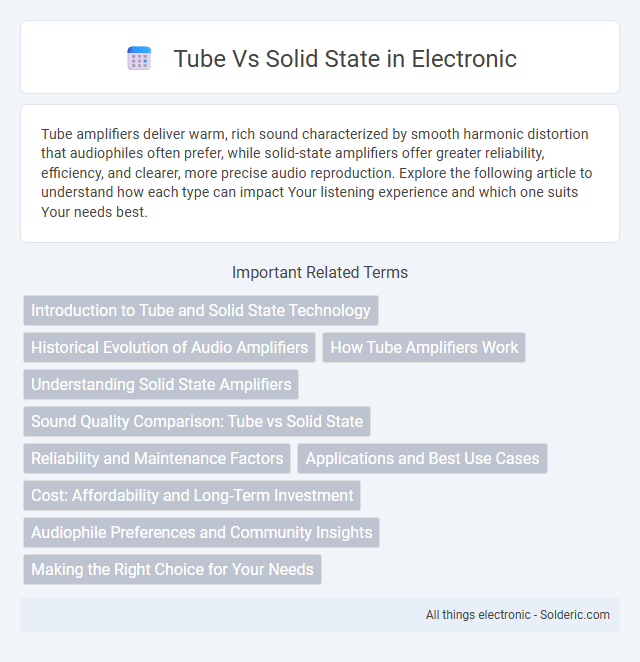Tube amplifiers deliver warm, rich sound characterized by smooth harmonic distortion that audiophiles often prefer, while solid-state amplifiers offer greater reliability, efficiency, and clearer, more precise audio reproduction. Explore the following article to understand how each type can impact Your listening experience and which one suits Your needs best.
Comparison Table
| Feature | Tube Amplifiers | Solid State Amplifiers |
|---|---|---|
| Sound Quality | Warm, natural, rich harmonic distortion | Clean, precise, low distortion |
| Durability | Fragile, sensitive to shock and heat | Robust, long-lasting, resistant to impact |
| Maintenance | Requires periodic tube replacement | Low maintenance, solid components |
| Size & Weight | Large, heavy due to tubes and transformers | Compact, lightweight |
| Cost | Typically expensive, niche market | Affordable, mass-produced |
| Power Efficiency | Less efficient, higher heat output | Highly efficient, low heat generation |
| Response Time | Smoother, slower attack | Fast, precise transient response |
| Common Use | Hi-fi audio, guitar amps, audiophiles | Home audio, professional audio, portable devices |
Introduction to Tube and Solid State Technology
Tube technology, rooted in vacuum tubes, uses electron flow through vacuum-sealed glass tubes to amplify audio signals, providing distinct warmth and harmonic richness. Solid-state technology relies on semiconductor components like transistors to amplify signals with greater efficiency, reliability, and compactness. Both technologies are fundamental in audio equipment, with tube amplifiers favored for their vintage tonal qualities and solid-state amplifiers valued for precision and durability.
Historical Evolution of Audio Amplifiers
The historical evolution of audio amplifiers traces back to the early 20th century, where vacuum tube amplifiers dominated due to their warm sound and high voltage handling capabilities. Solid-state amplifiers emerged in the 1960s with the development of transistor technology, offering increased reliability, smaller size, and greater energy efficiency. Today, both tube and solid-state amplifiers coexist, with audiophiles valuing tubes for their harmonic richness and solid-state devices praised for their precision and durability.
How Tube Amplifiers Work
Tube amplifiers operate by using vacuum tubes to amplify audio signals through the control of electron flow between electrodes in a vacuum. The key components include a cathode that emits electrons, a grid controlling the signal, and an anode that collects electrons, enabling voltage amplification with characteristic warm tonal qualities. Your listening experience benefits from the natural harmonic distortion and dynamic response unique to tube amplifier technology.
Understanding Solid State Amplifiers
Solid state amplifiers utilize semiconductor devices such as transistors to amplify audio signals, offering enhanced reliability and lower maintenance compared to tube amplifiers. These amplifiers deliver consistent performance, faster response times, and greater efficiency, making them ideal for modern sound applications. Solid state technology also allows for compact, lightweight designs without compromising on tonal clarity or power output.
Sound Quality Comparison: Tube vs Solid State
Tube amplifiers deliver a warm, rich sound with natural distortion and harmonic complexity preferred by audiophiles and musicians, creating a more organic and dynamic listening experience. Solid-state amplifiers offer cleaner, more precise sound reproduction with lower distortion and higher reliability, making them ideal for accurate audio monitoring and consistent performance. The choice depends on whether a user prioritizes tonal warmth and character (tube) or clarity and durability (solid state).
Reliability and Maintenance Factors
Tube amplifiers require more frequent maintenance due to their delicate vacuum tubes, which have a limited lifespan and can be prone to damage from heat and vibration. Solid state amplifiers offer superior reliability with fewer components subject to wear, resulting in lower maintenance demands and longer operational life. Your choice between tube and solid state should consider the trade-off between the vintage sound characteristics of tubes and the robust, low-maintenance nature of solid state technology.
Applications and Best Use Cases
Tube amplifiers excel in music production and audiophile settings due to their warm, rich sound and natural harmonic distortion, making them ideal for guitar amps and high-end audio systems. Solid state amplifiers are preferred in professional audio, broadcasting, and live sound reinforcement because of their reliability, efficiency, and lower maintenance. You should choose tube amps for tonal quality and vintage authenticity, while solid state amps suit environments demanding durability and consistent performance.
Cost: Affordability and Long-Term Investment
Tube amplifiers generally come with a higher initial cost due to their complex design and vintage components, making them less affordable upfront. Solid-state amplifiers offer greater affordability and durability, requiring less maintenance and providing a better long-term investment for budget-conscious users. Your choice should consider both the upfront price and potential repair or replacement costs over time.
Audiophile Preferences and Community Insights
Audiophile preferences often lean towards tube amplifiers for their warm, natural sound and harmonic richness that enhances musical expression, while solid state amplifiers are favored for their reliability, precision, and low distortion. Community insights reveal that tube amps are preferred in genres like jazz and blues for their smooth tonal qualities, whereas solid state systems dominate in genres demanding clarity and tight bass, such as electronic and rock music. Forums and reviews consistently highlight the subjective nature of sound quality, with many enthusiasts valuing tube amplifiers for their unique character despite the solid state's superior technical specifications.
Making the Right Choice for Your Needs
Choosing between tube and solid-state amplifiers depends on your desired sound quality and application; tube amps offer warm, rich tones preferred by audiophiles and musicians, while solid-state amps deliver reliability, lower maintenance, and consistent performance. Tube amplifiers excel in dynamic response and harmonic complexity, making them ideal for studio recording and vintage sound enthusiasts. Solid-state models provide cost-effective solutions with lightweight design, suited for live performances and portable setups.
Tube vs Solid State Infographic

 solderic.com
solderic.com